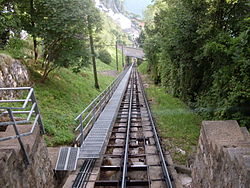Territet–Glion funicular railway
| Territet-Glion funicular railway | |
|---|---|

View down the line from Glion to Territet and Lake Geneva
|
|
| Overview | |
| Type | Funicular |
| Technical | |
| Number of tracks | single track with passing loop |
| Track gauge | 1,000 mm (3 ft 3 3⁄8 in) metre gauge |
| Maximum incline | (?) |
The Territet–Glion funicular railway (French: Chemin de fer funiculaire Territet–Glion) is a funicular in Switzerland, which runs between the Territet and Glion suburbs of the town of Montreux. At its upper terminus, the funicular connects with what was the lower terminus of the Chemin de fer Glion-Rochers-de-Naye (GN) mountain railway, which opened in 1892. This later line was joined, in 1909, in an end on junction at Glion with the newly constructed Chemin de fer Montreux-Glion (MGl).
The line was opened in 1883, making it one of the oldest funiculars in Switzerland (the Giessbachbahn, opened in 1879, is the oldest). It was built to 1,000 mm (3 ft 3 3⁄8 in) metre gauge with two separate and adjacent tracks which spread apart to allow passing at the halfway point. The stations had two side platforms.
In 1992 the company merged with Chemin de fer Montreux-Glion-Rochers-de-Naye, since 2001 they are part of Transports Montreux-Vevey-Riviera (MVR).
Up to the mid-1980s the railway operated by gravity alone: Both cars had a water tank under their decks and the one at the upper station was filled with water while the one at the lower station (Territet) was dumping its contents in Lake Geneva (Lac Leman). Once the fill-dump process and passenger boarding were complete the brakes were gradually released and since both cars were attached by a single cable passing over a pulley arrangement at Glion, the heavier car descended the slope carrying up the lighter car. The process was then repeated so the car uphill was always filled and the one downhill always empty and thus pulled uphill when brakes were released. An added picturesque note was that the two car operators were communicating for synchronisation with whistles instead of an intercom or similar device. Eventually the system was abandoned and the train now uses electric traction.
...
Wikipedia
